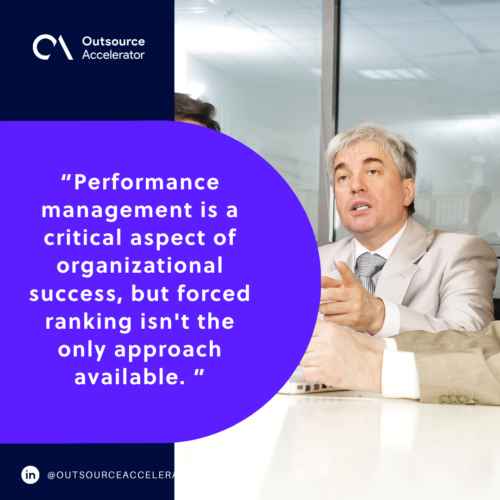Exploring the pros and cons of forced ranking

Employee performance evaluation is fundamental for effective talent management. It provides valuable insights into individual contributions, strengths, and areas for improvement within an organization.
Among the various performance evaluation methods, forced ranking has gained attention for its structured approach to differentiating employee performance. It has emerged as a controversial approach, sparking debates about its effectiveness and impact on organizational culture.
In this article, we’ll delve into the concept of forced ranking and critically assess its effectiveness. We’ll also explore alternative methods that businesses can consider to foster a more conducive and supportive work environment.
What is forced ranking?
Forced ranking is also known as “rank and yank” or “stack ranking.” It is a performance management method where employees within a team or organization are evaluated and ranked against each other based on their performance.
In forced ranking systems, employees are typically categorized into predetermined percentages, such as the following:
- Top – High performers (20%)
- Middle – Average performers (70%)
- Bottom – Low performers (10%)
This ranking system often results in consequences such as rewards for top performers and penalties or termination for low performers.
The use of this employee evaluation method has declined in recent years due to criticism and controversy surrounding its fairness and effectiveness. Despite this, some companies still utilize forced ranking, while others opt for alternative performance assessment techniques.

Pros of forced ranking
Forced ranking, even with ongoing debates, has been praised for several perceived advantages in performance management.
Let’s explore the key benefits of forced ranking:
Promotes differentiation among employees
Forced ranking encourages managers to differentiate between high-performing, average, and low-performing employees within the organization.
This differentiation helps identify top talent for rewards and recognition while addressing performance issues effectively.
Provides a clear performance measurement
With forced ranking, employees receive a clear indication of their performance relative to their peers. This transparency fosters a sense of accountability and motivates employees to improve their performance to advance within the organization.
Encourages healthy competition and motivation
The competitive nature of forced ranking can stimulate employees to strive for excellence and outperform their colleagues.
Knowing that their performance directly influences their ranking within the organization can fuel motivation and drive employees to excel in their roles.
Cons of forced ranking
Forced ranking may seem like an efficient way to evaluate employees. However, it also comes with several drawbacks that are said to hinder organizational effectiveness and morale.
Below, we have some of its downsides that businesses must be aware of:
Destructive competition
Forced ranking fosters a cutthroat environment where employees compete against each other for limited rewards or to avoid being labeled as low performers.
In some cases, it can lead to sabotage, lack of collaboration, and a toxic work culture.
Subjectivity and bias
Ranking employees is inherently subjective and prone to bias. Managers may favor certain employees or penalize others based on personal biases rather than objective performance metrics.
This can result in unfair treatment and demoralization among the workforce.
Focus on short-term results
Employees may prioritize short-term goals and behaviors that are easily quantifiable or noticeable. Some tend to think that doing so will improve their ranking rather than focusing on long-term growth and innovation.
This can stifle creativity and hinder strategic thinking within the organization.
Negative impact on morale and engagement
Being consistently ranked at the bottom can be demoralizing for employees, leading to:
- Decreased job satisfaction
- Disengagement
- Higher turnover rates
Forced ranking undermines teamwork and erodes trust between employees and management.
Limited development opportunities
In a forced ranking system, resources and career development opportunities are often allocated based on rank.
Lower-ranked employees will likely have fewer chances to grow and improve their skills, resulting in a stagnant workforce and hindering overall organizational performance.
Inhibition of diversity and inclusion
Forced ranking can exacerbate existing inequalities within the workplace. Staff from underrepresented groups may face additional barriers to advancement or be unfairly penalized in the ranking process.
It can undermine efforts to promote diversity and inclusion within the organization.
Focus on quantity over quality
Employees may feel pressured to prioritize quantity over quality in order to meet performance targets and improve their ranking.
This can result in rushed work, decreased attention to detail, and ultimately lower overall performance standards.
3 alternatives to forced ranking
Performance management is a critical aspect of organizational success, but forced ranking isn’t the only approach available.
Here are three alternatives that offer more balanced and constructive methods for evaluating employee performance:
1. 360-Degree Feedback
This approach provides a comprehensive assessment of an employee’s performance by collecting feedback from various sources, including:
- Managers
- Peers
- Subordinates
- External stakeholders
By gathering input from multiple perspectives, 360-degree feedback offers a more holistic view of an employee’s strengths and areas for improvement.
It encourages collaboration, fosters a culture of openness and transparency, and provides valuable insights for individual development.

2. Objectives and Key Results (OKRs)
OKRs are a goal-setting framework that focuses on defining specific, measurable objectives and key results to track progress and performance. Instead of comparing employees, OKRs emphasize personal and team goals aligned with the organization’s strategic objectives.
This method cultivates alignment, clarity, and accountability as employees work towards achieving shared goals that contribute to overall success.
OKRs encourage continuous improvement and empower employees to take ownership of their work and development.
3. Continuous feedback and coaching
Rather than relying on periodic performance evaluations, this approach emphasizes ongoing feedback and coaching conversations between managers and employees.
By providing regular, timely feedback, managers can offer guidance, support, and recognition to help employees develop their skills and address performance issues in real-time.
Continuous feedback helps:
- Drive a culture of learning and growth
- Build trust and rapport between managers and employees
- Enable agile adjustments to goals and priorities as circumstances evolve
These alternatives offer more collaborative, development-focused approaches to performance management. More importantly, they foster a positive work environment where employees are motivated to grow, contribute, and succeed.







 Independent
Independent




